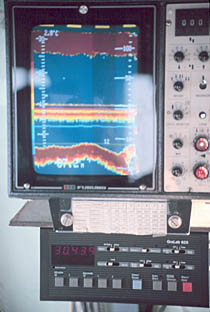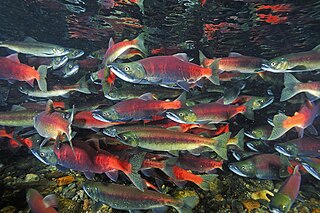Related Research Articles
Computer vision is an interdisciplinary scientific field that deals with how computers can gain high-level understanding from digital images or videos. From the perspective of engineering, it seeks to understand and automate tasks that the human visual system can do.

Lidar is a method for determining ranges by targeting an object with a laser and measuring the time for the reflected light to return to the receiver. Lidar can also be used to make digital 3-D representations of areas on the earth's surface and ocean bottom, due to differences in laser return times, and by varying laser wavelengths. It has terrestrial, airborne, and mobile applications.

Many types of fish migrate on a regular basis, on time scales ranging from daily to annually or longer, and over distances ranging from a few metres to thousands of kilometres. Fish usually migrate to feed or to reproduce, but in other cases the reasons are unclear.

Steelhead Trout is a name given to the anadromous form of the coastal rainbow trout (Oncorhynchus. m. irideus) or redband trout (O. m. gairdneri). The steelhead are native to freshwater and ocean environments across North America, but have been introduced to every other continent except Antarctica. Steelhead use aquatic obstructions like vegetation, boulders, and fallen trees as protection. Steelhead migrate to spawn during the summer months and the winter months.

An autofocus optical system uses a sensor, a control system and a motor to focus on an automatically or manually selected point or area. An electronic rangefinder has a display instead of the motor; the adjustment of the optical system has to be done manually until indication. Autofocus methods are distinguished by their type as being either active, passive or hybrid variants.

The Atlantic salmon is a species of ray-finned fish in the family Salmonidae. It is the 3rd largest of the Salmonidae, behind Siberian Taimen and Pacific Chinook Salmon, growing up to a meter in length. Atlantic salmon are found in the northern Atlantic Ocean and in rivers that flow into this ocean. Most populations of this fish species are anadromous, hatching in streams and rivers but moving out to sea as they grow where they mature, after which the adult fish seasonally move upstream again to spawn.

The sockeye salmon, also called red salmon, kokanee salmon, or blueback salmon, is an anadromous species of salmon found in the Northern Pacific Ocean and rivers discharging into it. This species is a Pacific salmon that is primarily red in hue during spawning. They can grow up to 84 cm in length and weigh 2.3 to 7 kg (5–15 lb). Juveniles remain in freshwater until they are ready to migrate to the ocean, over distances of up to 1,600 km (1,000 mi). Their diet consists primarily of zooplankton. Sockeye salmon are semelparous, dying after they spawn. Some populations, referred to as kokanee, do not migrate to the ocean and live their entire lives in fresh water.

Sea trout is the common name usually applied to anadromous forms of brown trout, and is often referred to as Salmo trutta morpha trutta. Other names for anadromous brown trout are sewin (Wales), peel or peal, mort, finnock (Scotland), white trout (Ireland) and salmon trout (culinary). The term sea trout is also used to describe other anadromous salmonids—coho salmon, brook trout, Arctic char, cutthroat trout and Dolly Varden. Even some non-salmonid species are also commonly known as sea trout—Northern pikeminnow and members of the weakfish family (Cynoscion).

Oncorhynchus is a genus of fish in the family Salmonidae; it contains the Pacific salmon and Pacific trout. The name of the genus is derived from the Greek ὄγκος + ῥύγχος, in reference to the hooked jaws of males in the mating season.

Hydroacoustics is the study and application of sound in water. Hydroacoustics, using sonar technology, is most commonly used for monitoring of underwater physical and biological characteristics.
A particle counter is used for monitoring and diagnosing particle contamination within specific clean media, including air, water and chemicals. Particle counters are used in a variety of applications in support of clean manufacturing practices, industries include: electronic components and assemblies, pharmaceutical drug products and medical devices, and industrial technologies such as oil and gas.
Acoustic tags are small sound-emitting devices that allow the detection and/or remote tracking of organisms in aquatic ecosystems. Acoustic tags are commonly used to monitor the behavior of fish. Studies can be conducted in lakes, rivers, tributaries, estuaries or at sea. Acoustic tag technology allows researchers to obtain locational data of tagged fish: depending on tag and receiver array configurations, researchers can receive simple presence/absence data, 2D positional data, or even 3D fish tracks in real-time with sub-meter resolution.
A people counter is an electronic device that is used to measure the number of people traversing a certain passage or entrance. Examples include simple manual clickers, smart-flooring technologies, infrared beams, thermal imaging systems, WiFi trackers and video counters using advanced machine learning algorithms. They are commonly used by retail establishments to judge the effectiveness of marketing campaigns, building design and layout, and the popularity of particular brands.

The food of the Tlingit people, an indigenous people from Alaska, British Columbia, and the Yukon, is a central part of Tlingit culture, and the land is an abundant provider. A saying amongst the Tlingit is that "When the tide goes out the table is set." This refers to the richness of intertidal life found on the beaches of Southeast Alaska, most of which can be harvested for food. Another saying is that "in Lingít Aaní you have to be an idiot to starve". Since food is so easy to gather from the beaches, a person who can't feed himself at least enough to stay alive is considered a fool, perhaps mentally incompetent or suffering from very bad luck. Though eating off the beach could provide a fairly healthy and varied diet, eating nothing but "beach food" is considered contemptible among the Tlingit, and a sign of poverty. Shamans and their families were required to abstain from all food gathered from the beach, and men might avoid eating beach food before battles or strenuous activities in the belief that it would weaken them spiritually and perhaps physically as well. Thus for both spiritual reasons as well as to add some variety to the diet, the Tlingit harvest many other resources for food besides what they easily find outside their front doors. No other food resource receives as much emphasis as salmon; however, seal and game are both close seconds.

Fisheries acoustics includes a range of research and practical application topics using acoustical devices as sensors in aquatic environments. Acoustical techniques can be applied to sensing aquatic animals, zooplankton, and physical and biological habitat characteristics.
Cell counting is any of various methods for the counting or similar quantification of cells in the life sciences, including medical diagnosis and treatment. It is an important subset of cytometry, with applications in research and clinical practice. For example, the complete blood count can help a physician to determine why a patient feels unwell and what to do to help. Cell counts within liquid media are usually expressed as a number of cells per unit of volume, thus expressing a concentration.
Sensors for arc welding are devices which – as a part of a fully mechanised welding equipment – are capable to acquire information about position and, if possible, about the geometry of the intended weld at the workpiece and to provide respective data in a suitable form for the control of the weld torch position and, if possible, for the arc welding process parameters.

Juvenile fish go through various stages between birth and adulthood. They start as eggs which hatch into larvae. The larvae are not able to feed themselves, and carry a yolk-sac which provides their nutrition. Before the yolk-sac completely disappears, the tiny fish must become capable of feeding themselves. When they have developed to the point where they are capable of feeding themselves, the fish are called fry. When, in addition, they have developed scales and working fins, the transition to a juvenile fish is complete and it is called a fingerling. Fingerlings are typically about the size of fingers. The juvenile stage lasts until the fish is fully grown, sexually mature and interacting with other adult fish.

The kokanee salmon, also known as the kokanee trout, little redfish, silver trout, kikanning, Kennerly's salmon, Kennerly's trout, or Walla, is the non-anadromous form of the sockeye salmon. There is some debate as to whether the kokanee and its sea-going relative are separate species; geographic isolation, failure to interbreed, and genetic distinction point toward a recent divergence in the history of the two groups. The divergence most likely occurred around 15,000 years ago when a large ice melt created a series of freshwater lakes and rivers across the northern part of North America. While some members of the salmon and trout family (salmonids) went out to sea (anadromous), others stayed behind in fresh water (non-anadromous). The separation of the sockeye and the kokanee created a unique example of sympatric speciation that is relatively new in evolutionary terms. While they occupy the same areas and habitats during the breeding season, when ocean-going sockeye salmon return to freshwater to spawn, the two populations do not mate with each other in some regions, suggesting speciation.
References
- Eatherley, D.M.R., Thorley, J.L., Stephen, A.B., Simpson, I., MacLean, J.C. & Youngson, A.F. (2005). Trends in Atlantic salmon: the role of automatic fish counter data in their recording. Scottish Natural Heritage Commissioned Report No. 100 (ROAME No. F01NB02).
- The Estimation of Individual Fish Size Using Broadband Acoustics with Free-swimming Salmonids, Thomas J. McKeever. Masters Thesis in Aquaculture, University of Newfoundland, 1998.


